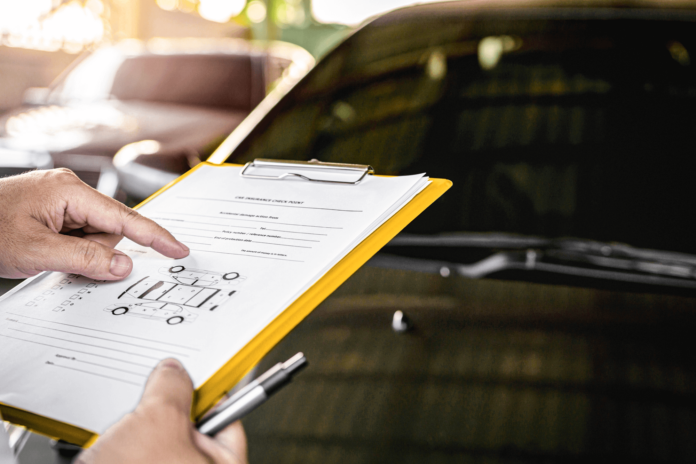Buying a used car can be intimidating especially if you’re not sure how to inspect the car for signs of accident damage. While minor scratches and dents on a used car are totally normal, having major accident damage can pose a danger to you and your passengers. To help you the next time you shop for a pre-owned car, here are six car inspection tips shared by the professional, skilled inspectors at CARSOME.

[Image source: 3dbodyworks.com]
1. Look for Mismatched Paint
Checking for mismatched paint is one of the easiest car inspection tips. Usually, if a car has been in an accident, only the damaged area or panel is repaired. This can be done by either replacing the damaged panel or respraying the affected area. When checking for mismatched paint, remember to do it under good light. Also, you should only compare surfaces of the same material since different materials have different properties that can affect the paint color.
For example, you can compare the paint on the door panel (metal surface) with the fenders or bonnet, but not with the bumpers since the bumpers are made of plastic. You also shouldn’t compare the paint on the roof with other parts of the car as the paint there tends to fade faster as it is subjected to harsher sunlight on a daily basis.
2. Check the Paint on the Edges of the Bonnet and Boot Lid
One simple car inspection tip is to check the edges of the bonnet and boot lid and feel for uneven or rough paint textures. If the bonnet and boot have been repainted after an accident, the paint on the edges tends to have a rough texture.
On the other hand, the original factory paint should feel smooth and even. While having rough paint edges could indicate that the car has been in an accident, it could also be a sign that the owner repainted the car just to refresh its looks.
Read More: Sedan vs SUV: Does Size Really Matter?
3. Check the Sealant around the Car
Most manufacturers apply automotive seam sealant along the seams of the body parts of a car including the doors, bonnet, and boot lid of a car to bond the metal surfaces together. During your car inspection, check the edges of the car door and press down on the sealant layer which can be either in black or in the car’s body color.
The original factory sealant should feel hard and dense, and can’t be easily compressed with your fingers. If you can compress the sealant with your touch, chances are the car has undergone some repairs that require new sealant to be applied.

Seam sealant on the edges of the boot opening
4. Check for Bubbles Due to Dust Contamination
Cars with the original factory paint are generally smooth and blemish-free since they are painted in a dust-free car painting chamber. In contrast, most third-party paint shops don’t have a properly enclosed painting chamber. When you repaint a car that has dust particles on the surface, tiny paint bubbles can form around the dust particles.
The bubbles can range in size from tiny to large, and are usually inconspicuous to the untrained eye so they may be difficult to spot. When trying to spot paint bubbles, do it in a well-lit area and keep a torch on hand.

Tiny paint bubbles due to dust contamination
Read More: A Guide to the Easiest Car Colors to Maintain
5. Look at the Welding Spots around the Car
A car is made of multiple sheets of metal fused together with a process called spot welding. This process results in circular dents or spots around the car called welding spots. You can find the welding spots on certain metal surfaces of the car including in the engine bay and on the door frame underneath the rubber seal that surrounds the door.

Welding spots in a car’s engine bay
The factory welding spots on a car are always uniform in width and depth. However, If the car has suffered damage that requires repairs and extra welding, you may notice some welding spots that look out of place.
6. Inspect the Car for Mud Stains
Inspecting a car for flood damage is difficult without a jack as you wouldn’t be able to thoroughly inspect the car’s undercarriage. However, you can check parts of the car such as around the door hinges and under the carpet for mud stains. These areas are harder to clean and tend to hold more mud. You can also pull the seatbelts till they’re fully extended and look for stains on the end of them as these are usually overlooked.
Choose CARSOME Certified for Complete Peace of Mind
If you’re looking for a quality pre-owned car, look no further than CARSOME. We put all our cars through a stringent 175-point inspection that covers the exterior, interior, underbody, and road test to rule out major accidents and flood damage. CARSOME Certified cars then undergo a professional refurbishment process to ensure they have safety beyond standards, complete comfort, and refurbished aesthetics.
Additionally, each CARSOME Certified car offers excellent value with the following promises.
- Fixed price: The listing price you see on CARSOME is the actual full price of the car with no hidden fees, so you know exactly how much you’re paying.
- Five-day money-back guarantee: If you buy a car from CARSOME and you change your mind, you can return it within five days and get a full refund. No questions asked!
- One-year warranty: All CARSOME Certified cars also have a one-year extended warranty for your peace of mind.
Check out CARSOME to find your dream car today!
